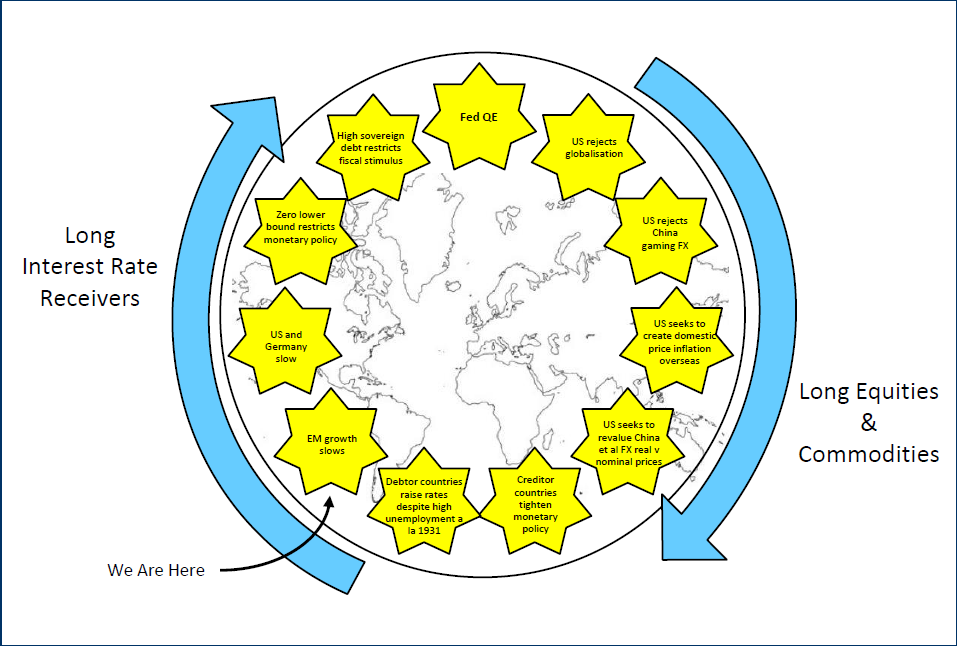So, the game of QE3 is afoot.
Let’s begin with an excerpt from John Hilsenrath of the WSJ:
Federal Reserve officials are in no hurry to respond to recent indications U.S. economic growth has hit another soft patch, despite chatter in financial markets that the Fed might start a new program of U.S. Treasury-bond purchases to boost growth.
The central bank has already purchased more than $2 trillion of mortgage and Treasury bonds. The purchases are meant to hold interest rates down by reducing the supply of securities in private hands and to drive investors into areas such as stocks to encourage businesses and consumers.
Fed Chairman Ben Bernanke signaled in April that the hurdle to more “quantitative easing,” as it is known, is very high and Fed officials have done nothing to indicate that Mr. Bernanke’s guidance has changed as economic data has worsened in recent weeks.
In an April news conference, Mr. Bernanke said the tradeoffs that would come with additional purchases were becoming unappealing. “It’s not clear we can get substantial improvements in [employment] without some additional inflation risk,” he said.
Fed officials have largely held to that line. In comments last week, St. Louis Fed president James Bullard said the Fed was entering a period in which Fed policy will be on pause—meaning it won’t be trying to push interest rates either higher or lower. Charles Evans, president of the Chicago Fed and a strong advocate of past programs, said earlier last month that what the Fed had done already was “sufficient.”
In comments Wednesday, Cleveland Fed president Sandra Pianalto said the Fed’s current stance was appropriate and added the recovery was likely to continue, even though growth “may be frustratingly slow at times.”
Mr. Bernanke has argued that past bond purchases haveworked, but it has have taken a political toll on the Fed. Critics in Congress and overseas say the Fed is fueling inflation globally.
“They don’t want to do QE3,” said Vincent Reinhart, an economist who formerly ran the Fed’s influential division of monetary affairs. QE3 is what many traders have dubbed the possibility of a third round of Fed securities purchases. The last round of quantitative easing, which will amount to $600 billion of bond purchases, is set to conclude at the end of June.
Hilsenrath is generally thought to be close to the Fed so way can probably take this as some proxy for the line we’re likely to hear from Bernanke and Co. over the next few months.
Also last night, Mohammed El-Erian of PIMCO appeared to make similar points. He is long exposure to risk assets and sees no chance of QE3.
Later in the interview, the CNBC anchor rightly thrashes El-Erian for missing the latest rally in Treasuries (PIMCO famously bailed out of the US debt some months ago). This highlights that El-Erian is potentially conflicted in his view. Ironically, PIMCO seems to have forgotten its own notion of the “new normal”.
Fact is, as I wrote yesterday, we’re going to have to see an accident before QE3 can come, which is precisely where we find John Taylor, who forecasts a US recession by year end and a miserable 2012:
I suggest you take the time to watch the entire video, Taylor heads FX Concepts, the largest FX fund in the world. He forecasts a US recession as the current slowing is exacerbated by fiscal austerity. He also forecasts a rising $US. Taylor acknowledges the bar for QE3 is high and his timeframe is slower than mine but we’re singing from the same hymn sheet.
I’ve seen this same discussion played out over and again through the last three US business cycles. The Fed always says its going to play it tough. The politicians are always bleating about the US becoming the Weimar Republic. Both always capitulate when the market does.
Still, I can’t discount the possibility that John Taylor is right about the bar being so high for QE3 that it will take a cycle ending event (which he sees coming) to bring it on.
Basically, we are closing in on a moment for the US economy that is the monetary equivalent of the fiscal baulking that triggered the Lehman collapse. I don’t mean we’re about to enter GFC 2.0, rather that the market has grown so confident of being bailed out, that when authorities turn on a dime, arbitrarily as it were, as they did with Lehman, the whole place goes to hell.
Ultimately, of course, QE3 will come, whether, as I think, before the cycle ends or, as John Taylor thinks, afterwards. The inevitability of it is captured beautifully in the below diagram from Hugh Hendry:

Them’s structural forces at work.
A Greek bailout and better than expected BLS tomorrow may give us some fuel for a rally next week but behind that I see building thunderheads: Japan struggling, China slowing and still tightening, US growth slowing sharply and liquidity about to be pulled, the $US bottoming, the core of Europe slowing even as the periphery limps on and commodities at astronomic levels.
To me it all says equities and commodities accident ahead, QE3 to follow.

